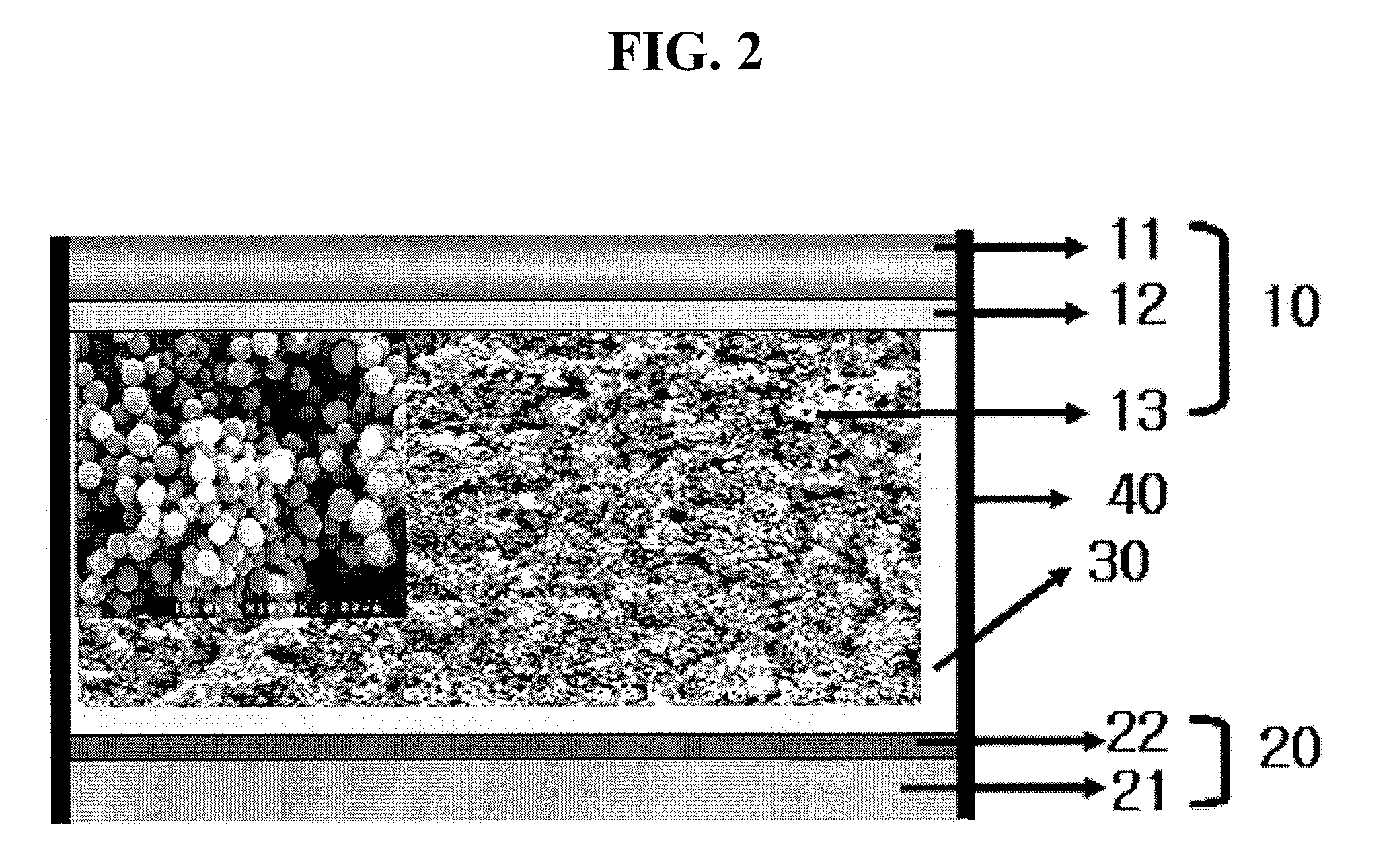Dye-sensitized solar cell comprising metal oxide nanoball layer and preparation method thereof
a metal oxide nanoball and solar cell technology, applied in the direction of semiconductor devices, capacitors, electrolytic capacitors, etc., can solve the problems of low photo-energy conversion efficiency of the conventional dye-sensitized solar cell, deterioration of short-circuit current density, and often cracking of the titanium oxide layer, etc., to achieve excellent electron transport ability, improve photoelectric conversion efficiency, and high dye adsorption efficiency
- Summary
- Abstract
- Description
- Claims
- Application Information
AI Technical Summary
Benefits of technology
Problems solved by technology
Method used
Image
Examples
example 1
[0076]3 wt % of titanium oxide nanopowder (P-25, Degussa Co., Ltd., Germany) having a diameter of 20 nm and a specific surface area of 54 m2 / g was uniformly dispersed in a mixed solvent of ethanol and butanol (weight ratio of 1:1) using a micro bead mill to prepare a dispersion. The dispersion was applied onto a conductive glass substrate using an electrospray method, to obtain titanium oxide nanoballs which are agglomerated titanium oxide nanoparticles accumulated on the substrate and have an average diameter of 750 to 1500 μm. Then, the substrate comprising the titanium oxide nanoballs was heat-treated at 500° C. for about 30 min to form a titanium oxide nanoball layer having a thickness of 12.4 μm.
example 2
[0077]A titanium oxide nanoball layer having a thickness of 12.4 μm was formed under the same conditions as Example 1, except that the substrate comprising the titanium oxide nanoballs was thermally pressed under a pressure of 5.5 tons (5×5 cm) at 120° C. for about 30 min followed by heat-treating at 500° C. for about 30 min.
example 3
[0078]A high-density blocking layer was coated on a transparent conductive substrate by spin-coating the transparent conductive substrate (10×10 cm) with a butanol solution containing 2M titanium bis(ethylacetoacetato)diisopropoxide (99.9%, C18H34O8Ti, Aldrich Co., Ltd.) at 200 rpm for 60 seconds using a spin coater (Spin-3000D, PTL Korea Co., Ltd.) followed by sintering the resulting substrate at 450° C. for 30 min. A titanium oxide nanoball layer was formed on the obtained blocking layer under the same conditions as Example 2.
PUM
| Property | Measurement | Unit |
|---|---|---|
| specific surface area | aaaaa | aaaaa |
| diameter | aaaaa | aaaaa |
| temperature | aaaaa | aaaaa |
Abstract
Description
Claims
Application Information
 Login to View More
Login to View More - R&D
- Intellectual Property
- Life Sciences
- Materials
- Tech Scout
- Unparalleled Data Quality
- Higher Quality Content
- 60% Fewer Hallucinations
Browse by: Latest US Patents, China's latest patents, Technical Efficacy Thesaurus, Application Domain, Technology Topic, Popular Technical Reports.
© 2025 PatSnap. All rights reserved.Legal|Privacy policy|Modern Slavery Act Transparency Statement|Sitemap|About US| Contact US: help@patsnap.com



